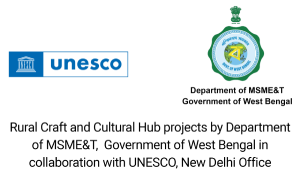Chadar Badar or Chadar Badoni is a form of tribal (santhal) puppetry found in parts of Jharkhand and Birbhum, Dinajpur and Bardhaman districts of West Bengal. It is a form of string puppetry, which comprises of two rows of puppets, adorned in tribal attire, faced opposite to each other. One row comprises of a group of tribal women, and the other row comprises of two or three musicians playing folk musical instruments like Madol, Dhol. In between these two groups of puppets, is the ‘Rashik’ puppet, an intoxicated man engrossed with the tribal song and dance as enacted by the puppets. The puppets are carved out of wood.
This form of string puppetry is a curious amalgamation of indigenous craftsmanship and technology. The puppets are tied with strings, which are tied to the feet of the puppeteer, who operates and makes the puppets dance to the tunes. The puppets are attached to a central lever, moving which makes the puppets’ hands and feet move. The puppets dance to the tunes of songs, sung by the puppeteer, accompanied by folk musical instruments like Banam, Flute, Madol, Dhol. The instruments are locally made by the puppeteers themselves and carved out of bamboo. The stage of Chador Bador varies from place to place. While in Dinajpur, the stage is square shaped, Birbhum and Bardhaman’s Chador Bador takes place in a spherical stage. The stage is open on all sides and the lower part of the stage, where the lever is attached, is covered with cloth and it is because of this cloth covering, this form of puppetry derives its name ‘Chador Bador’ (Chador Bador or Chador Badoni meaning covered with cloth). The theme of the songs, which accompany the dance of the puppets, cover a range of topics including tribal lifestyle, grievances of wives towards their husbands, social awareness issues like eradication of child marriage, health and hygiene related issues like prevention of dengue and malaria and others. The diverse themes of songs accompanying the performance of Chador Bador reveals that this form of puppetry is not just emblematic of tribal culture but is also used as a medium to transmit messages on social awareness and is hence infused with educatory flavor.
Total 76 artists are covered in Purba Bardhaman district under the RCCH II initiatives.



